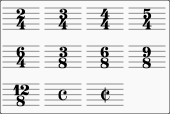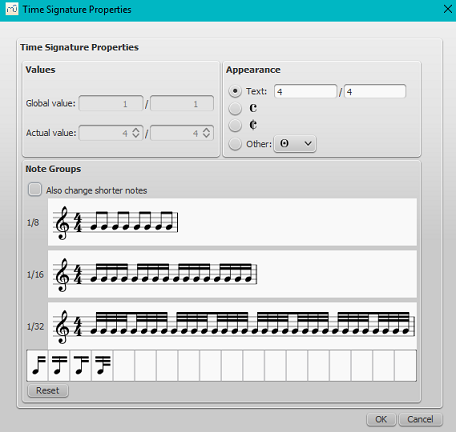Time signatures
Time signatures can be found in a Palette of the same name in both the Basic and Advanced workspaces.

Note: Whether or not a time signature is actually shown depends on the staff properties, by default it is not shown for tablature.
Add or replace a time signature
Use any of the following methods:
- Select a time signature, measure, note or rest, and click a time signature in a palette (double-click in versions prior to 3.4).
- Drag and drop a time signature from a palette onto a space in a measure, or onto an existing time signature.
Delete a time signature
- To delete a time signature in the score, select it and press Del.
Create a time signature
If the time signature you require is not available in any of the existing palettes, it can be created using one of the following methods:
From the Time Signatures palette
Available as of version 3.3.
- In the Time Signatures palette, click on "More", then, in the supplementary palette, click on the "Create Time Signature" button;
- In the top line, enter the Numerator, Denominator, and Text (the latter is optional where you need the display to be different from the actual time signature).
- Adjust the note beaming in the Note Groups section.
- Press the "Add" button to transfer the newly-created time signature to the Time Signatures palette.
From the Master palette
- Press Shift+T to display the Time signatures section of the Master Palette;
- Select a time signature to edit in the center panel;
- In the top line of the Create Time Signature panel, enter the Numerator, Denominator, and Text (the latter is optional where you need the display to be different from the actual time signature).
- Adjust the note beaming in the "Note group" section".
- Press Add to add the newly-created time signature to the center panel. To delete a time signature from the center panel, right-click (Mac: Ctrl-click) on it and select Clear.
- Drag and drop the time signature from the Master Palette to the Time Signatures palette. You can also drag the time signature direct to the score, if desired.
Fractional time signatures
Starting in version 3.5.1 there is limited support for fractional time signatures. Only ½ and ¼ are supported at this time. If your keyboard does not have the characters on them you can enter them using Alt+0189 for ½ and Alt+0188 for ¼ on some operating systems. You can also copy/paste from here.
Time signature properties
To edit properties of particular time signature object(s) on a score, use the Time Signature Properties dialog. Do either one of the following:
- Select the time signature, then click on "Properties" in the "Time Signature" section of the Inspector, or
- Right-click (Mac: Ctrl-click) on a time signature and select Time Signature Properties….

- Global value: Shows the data used by Musescore to create metronome tick audio, see Tempo chapter. Not modifiable. It is also shown in the status bar.
- Actual value: Shows the data used by Musescore to create local time signature, see "Local time signatures" section. Not modifiable.
- Appearance: Specify a displayed text for engraving purpose, it does not affect the score. See "Additive meters" section.
- Note Groups: Controls beaming of notes. See Beams chapter.
Additive (composite) meters
Additive (or composite) time signatures are sometimes used to clarify the division of beats within a measure. To use an additive time signature:
- Create a new custom time signature, see above, or
- Modify an existing time signature on the score:
- Right-click (Mac: Ctrl-click) on a time signature in the score and select Time Signature properties…;
- In the Appearance section, adjust the "Text" property as required;
- Adjust note beaming in the Note Groups section if required.
Local time signatures
In certain cases a score may show staves with different time signatures running at the same time. For example, in Bach's 26. Goldberg Variation:

In the above example, the global time signature is 3/4, but the time signature of the upper staff has been set independently to 18/16.
To set a local time signature for just one staff:
- Hold down Ctrl (Mac: Cmd) and drag and drop a time signature from a palette onto an empty measure.
Resize time signature
- Select one or more time signatures and, in the "Time Signature" section of the Inspector, adjust the "Scale X" (width) and "Scale Y" (height) values.
Pickup measures and cadenzas
Occasionally you will need to decrease or increase the duration of a measure without changing the time signature—for example, in a pickup measure (anacrusis) or in a cadenza etc. See Measure operations: Measure duration.
Time signature changes and breaks
Multimeasure rests are interrupted when a time signature change occurs. Also, a section break will prevent a courtesy time signature being shown at the end of the previous measure.
See also
External links
- How To Using Polyrhythm, mixed meters and local time signatures in MuseScore (MuseScore HowTo)
- Additive meters at Wikipedia.